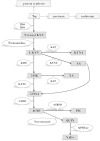Immunomodulatory Effects of Genetic Alterations Affecting the Kynurenine Pathway
- PMID: 31781097
- PMCID: PMC6851023
- DOI: 10.3389/fimmu.2019.02570
Immunomodulatory Effects of Genetic Alterations Affecting the Kynurenine Pathway
Abstract
Several enzymes and metabolites of the kynurenine pathway (KP) have immunomodulatory effects. Modulation of the activities and levels of these molecules might be of particular importance under disease conditions when the amelioration of overreacting immune responses is desired. Results obtained by the use of animal and tissue culture models indicate that by eliminating or decreasing activities of key enzymes of the KP, a beneficial shift in disease outcome can be attained. This review summarizes experimental data of models in which IDO, TDO, or KMO activity modulation was achieved by interventions affecting enzyme production at a genomic level. Elimination of IDO activity was found to improve the outcome of sepsis, certain viral infections, chronic inflammation linked to diabetes, obesity, aorta aneurysm formation, and in anti-tumoral processes. Similarly, lack of TDO activity was advantageous in the case of anti-tumoral immunity, while KMO inhibition was found to be beneficial against microorganisms and in the combat against tumors, as well. On the other hand, the complex interplay among KP metabolites and immune function in some cases requires an increase in a particular enzyme activity for the desired immune response modulation, as was shown by the exacerbation of liver fibrosis due to the elimination of IDO activity and the detrimental effects of TDO inhibition in a mouse model of autoimmune gastritis. The relevance of these studies concerning possible human applications are discussed and highlighted. Finally, a brief overview is presented on naturally occurring genetic variants affecting immune functions via modulation of KP enzyme activity.
Keywords: IDO; KMO; TDO; genetic manipulation; immunomodulation; kynurenine pathway.
Copyright © 2019 Boros and Vécsei.
Figures



References
Publication types
MeSH terms
Substances
LinkOut - more resources
Full Text Sources
Research Materials

